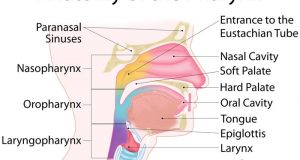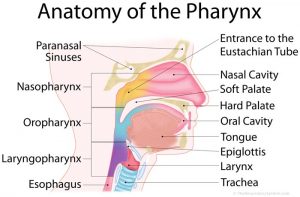Published on October 1st 2016 by admin under Upper Respiratory Tract
What is the Pharynx
Pharynx is the 4-5 inches long semicircular fibromuscular tube, commonly referred to as the throat [1] that connects the nasal cavity to the larynx, and the oral cavity to the esophagus [2, 3].
Where is the Pharynx Located
Located just below the nasal and oral cavities and before the larynx and esophagus, the pharynx starts at the human skull base, extending to the lower end of the cricoid cartilage [4].
Parts of the Pharynx – Anatomy and Structure
It consists of the nasal, oral, and laryngeal divisions [5]:
Nasopharynx (Nasal Pharynx)
It is the uppermost section, located between the skull base and the soft palate [3]. The adenoids or pharyngeal tonsils are located on its posterior wall [6].
Oropharynx (Oral Pharynx)
The part after the nasopharynx, the oropharynx is the region behind the base of the tongue, between the soft palate and the epiglottis [7].
Laryngopharynx
Also known as the hypopharynx, it is the last section of the pharynx, located between the epiglottis and the cricoid cartilage, continuing into the larynx and esophagus [4].
Muscles of the Pharynx
The pharynx walls have two types of muscle structures:
The Outer Circular Layer
These are positioned as incomplete muscular circles, all innervated by the nervus vagus (vagus nerve) [5]. There are three circular muscles [8, 9]:
- Superior pharyngeal constrictor, located in the oropharynx
- Middle pharyngeal constrictor, located in the laryngopharynx
- Inferior pharyngeal constrictor, also located in the Laryngopharynx, divided into the superior (having oblique fibers attaching to thyroid cartilage) and inferior (having horizontally placed fibers attaching to cricoid cartilage) components [3].
The Inner Longitudinal Layer
There are three paired longitudinal muscles in the human pharynx [10]:
- Stylopharyngeus – Extends to the pharynx from the temporal bone’s styloid process
- Palatopharyngeus – Extends from the oral cavity’s hard palette
- Salpingopharyngeus – Extends from the Inferior cartilage of the Eustachian tube [11]
The vagus nerve innervates the palatopharyngeus and salpingopharyngeus, while the glossopharyngeal nerve innervates the stylopharyngeus [3].
Pharyngeal Blood Supply
Arterial Supply: Through external carotid artery branches, namely the ascending pharyngeal artery, lingual artery, facial artery and maxillary artery.
Venous Drainage: Performed by the venous pharyngeal plexus that drains into the IJV (internal jugular vein).
Functions – What Does the Pharynx Do
Since it works as the connecting tube between the nasal cavity and larynx, as well as the oral cavity and esophagus, the pharynx is an integral part of both the respiratory and digestive systems.
Functions in the Respiratory System
Here, its primary purpose is to let inhaled air pass from the nasal cavity to the larynx, windpipe and then the lungs [6]. The passage connecting the oral and nasal pharynges, called isthmus, allows humans to breathe both through the nose and mouth [12].
The epiglottis, located at the end of the oropharynx keeps the passage to the esophagus covered, so the air does not enter into the digestive system. The Eustachian tubes act as a connection between the pharynx and middle ear, helping in equalizing the pressure of air on the eardrum [12].
Functions in the Digestive System
The consecutive contractions of the circular muscles of the pharynx help the ingested foods to pass through the lumen into the esophagus [10]. The longitudinal muscles contribute to widening the pharynx, elevating the larynx during the process of swallowing [3].
Functions in Speech
The pharynx works with the other speech organs and muscles to produce initial sounds, while it also plays the role of a resonating organ.
Conditions Associated with Pharynx
- Pharyngitis, an inflammatory condition causing swelling, pain during swallowing, redness, and scratchiness, along with white patches in the throat [13]
- Tonsillopharyngitis, a viral (or bacterial) throat infection causing pain and difficulty swallowing [14]
- Pharynx cancer, causing a lumpy feeling in the throat or neck, bleeding, nasal obstruction, ear and throat pain, problems with swallowing and even deafness [15].
- Throat paralyses resulting from infectious diseases like diphtheria, rabies, and polio [12]
- Pharynx ‘cobblestoning’ due to allergic rhinitis, characterized by streaks of lymphatic tissue, marking the back of the pharynx [16]
- Laryngopharyngeal reflux (LRP), common in those suffering from GERD, occurs when the stomach acids get up to the throat from the esophagus
References
- http://www.ncbi.nlm.nih.gov/pubmedhealth/PMHT0024473/
- http://emedicine.medscape.com/article/1949347-overview
- http://teachmeanatomy.info/neck/viscera/pharynx/
- http://biyaninursingcollege.com/what-is-pharynx-its-position-structure-and-functions/
- https://www.dartmouth.edu/~humananatomy/part_8/chapter_53.html
- http://study.com/academy/lesson/pharynx-anatomy-definition-quiz.html
- http://www.getbodysmart.com/ap/respiratorysystem/pharynx/regions/tutorial.html
- http://www.yorku.ca/earmstro/journey/pharynx.html
- https://www.csuchico.edu/~pmccaffrey//syllabi/SPPA342/342unit3.html
- https://www.kenhub.com/en/library/anatomy/muscles-and-walls-of-the-pharynx
- http://www.gpnotebook.co.uk/simplepage.cfm?ID=x20091027230110724280
- https://www.britannica.com/science/pharynx
- http://www.healthline.com/health/pharyngitis#Overview1
- http://www.merckmanuals.com/professional/ear,-nose,-and-throat-disorders/oral-and-pharyngeal-disorders/tonsillopharyngitis
- http://patient.info/doctor/pharyngeal-cancer
- http://emedicine.medscape.com/article/134825-overview
- http://my.clevelandclinic.org/services/head-neck/diseases-conditions/hic-laryngopharyngeal-reflux-lpr










Very well I get a knowledge about pharynx